
- Usage in publication:
-
- Pikes Peak granite*
- Modifications:
-
- Original reference
- Dominant lithology:
-
- Granite
- AAPG geologic province:
-
- Southern Rocky Mountain region
Summary:
Pikes Peak granite. The mass of Pikes Peak is principally made up of a single granite type, belonging to what is apparently one great body, extending for many miles in all directions. The main type is a very coarse-grained biotite granite or granitite, in most places red. In the Pikes Peak type proper biotite is quite subordinate, but on either side of Platte River, and in several places in southwestern part of district, a large increase in black mica greatly changes appearance of rock. The Pikes Peak type is cut by a fine, even-grained reddish and pinkish granite poor in mica. [Age is pre-Cambrian.]
Source: US geologic names lexicon (USGS Bull. 896, p. 1658-1659).
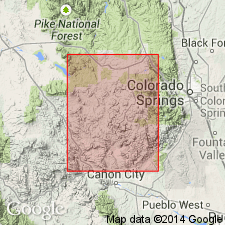
- Usage in publication:
-
- Pikes Peak type*
- Modifications:
-
- Revised
- Overview
- AAPG geologic province:
-
- Southern Rocky Mountain region
Summary:
A large part of the area mapped in the Pikes Peak folio, El Paso Co, CO in the Southern Rocky Mountain region, is a single type of granite characterized by large pink or gray feldspar and quartz grains. Some of the feldspar phenocrysts are several inches in diameter. The fresh unaltered granites are coarse-grained aggregates of quartz, perthitic feldspar, and biotite with occasional accessory hornblende or fluorite, microscopic apatite, zircon, titanite, magnetite, rutile, hematite, limonite, epidote and allanite. Texture varies from that in which feldspar is only slightly larger than quartz to one where feldspar stands out in large imperfectly formed porphyritic crystals. The most important feldspar is microcline. Considered to be the oldest granite in the report area. Is cut by many dikes of Summit type (first used) and by finer grained rocks of Cripple Creek type (first used). Rock disintegrates before it is decomposed. Effect of weathering extends 2 or 3 ft beneath the surface. Forms thick talus and granite. Of Algonkian age. Small geologic sketch map.
Source: GNU records (USGS DDS-6; Denver GNULEX).
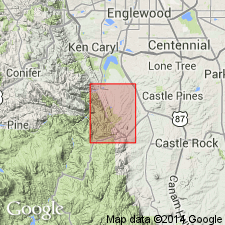
- Usage in publication:
-
- Pikes Peak Granite*
- Modifications:
-
- Mapped 1:24k (Kassler quad, Douglas and Jefferson Cos, CO)
- Dominant lithology:
-
- Granite
- AAPG geologic province:
-
- Denver basin
Summary:
Is Precambrian lithodeme mapped in northwestern Douglas Co, CO (Southern Rocky Mountain region). Is only formal Precambrian lithodemic unit in quad. Occurs along southern edge of quad. Consists of two separately mapped units: (1) coarse-grained moderate reddish-orange granite composed of microperthite, quartz, and biotite and (2) granite pegmatite, crystal-lined miarolitic cavities, vein-like pegmatites, and pegmatized border zone. Outcrops as rounded cubical shapes due to weathering along joints. Mineralogy of three samples listed (table, p.84). In contact with Precambrian metamorphic rocks.
Source: GNU records (USGS DDS-6; Denver GNULEX).
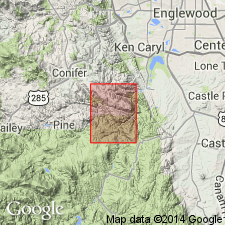
- Usage in publication:
-
- Pikes Peak Granite*
- Modifications:
-
- Mapped 1:24k (Platte Canyon quad, Douglas and Jefferson Cos, CO)
- Dominant lithology:
-
- Granite
- AAPG geologic province:
-
- Southern Rocky Mountain region
Summary:
Is Precambrian(?) lithodeme mapped in western Douglas and southeastern Jefferson Cos, CO (Southern Rocky Mountain region). Is only formally named unit in quad. On map explanation, unit is shown to be older than Precambrian(?) foliated basic dike unit and younger than all other informal Precambrian? lithodemic units; contact with older rocks is sharp. Outcrops over southwestern one-third of quad. Separately mapped as pink coarse-grained seriate granular granite unit; faintly mottled light-gray and light pinkish-gray medium-grained seriate granular to porphyritic quartz monzonite unit in gradational contact with granite unit; and as inclusions of gneisses, intruded and enveloped by fine-grained alaskite. Crops out in smooth, rounded masses. Cut by dikes of fine-grained alaskite; dikes are less than an inch up to 10 ft thick. Pegmatites are common in Pikes Peak; they range from 1 to several hundred ft across but most are 5-50 ft in maximum dimension. In places contains thin, dark, curved layers (or veins) that contain abundant allanite as well as feldspar, quartz, biotite, and fluorite. Pikes Peak also contains many inclusions of metasedimentary rock and migmatite.
Source: GNU records (USGS DDS-6; Denver GNULEX).
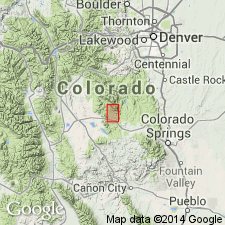
- Usage in publication:
-
- Pikes Peak Granite*
- Modifications:
-
- Revised
- AAPG geologic province:
-
- Southern Rocky Mountain region
Summary:
A granite formerly called the late facies of the Pikes Peak Granite is separated from the Pikes Peak and named Redskin Granite. The Pikes Peak occurs in the north and northeast parts of the Lake George area, Park Co, CO in the Southern Rocky Mountain region. The granite is coarse grained, subequigranular to porphyritic, and at most places massive to very faintly foliated but potassic feldspars are markedly aligned in a primary foliation locally. Pikes Peak is cut by dikes or irregular masses of pegmatite, aplite-pegmatite, fine-grained granite, and granite porphyry. Is classified as epizonal because of its discordant contacts, massive structure, and local miarolitic nature. Isotopic ages reported from previous reports of 980, 1,000, 1,060, and 1,080 m.y. Geologic map. Chemical analyses.
Source: GNU records (USGS DDS-6; Denver GNULEX).
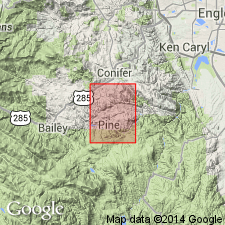
- Usage in publication:
-
- Pikes Peak Granite*
- Modifications:
-
- Mapped 1:24k (Pine quad, Jefferson Co, CO)
- Dominant lithology:
-
- Granite
- Granodiorite
- Quartz monzonite
- AAPG geologic province:
-
- Southern Rocky Mountain region
Summary:
Is Precambrian Y [Middle Proterozoic] lithodeme mapped in southern Jefferson Co, CO (Southern Rocky Mountain region). Is youngest Precambrian unit in quad. On Correlation of Map Units is shown to unconformably underlie Tertiary gravel unit and to be younger than Silver Plume Quartz Monzonite (Precambrian Y). Occurs in most of southern half of quad. Is divided into two map units, a granite unit and granodiorite and quartz monzonite unit. Granite is described as coarse-grained white to moderate-orange-pink biotite and hornblende-biotite granite with a grain size of 0.5-2 cm; contains a few dikes and inclusions of aplite and a few pods and dikes of pegmatite; forms large slabby outcrops and thin sandy soil except along fracture zones where outcrops are smaller and angular, and soil is deeper. Granodiorite and quartz monzonite unit is described as coarse-grained, light-greenish-gray, commonly porphyritic biotite and biotite-hornblende; contains potassic feldspar grains 0.5-2 cm; contacts with granite unit are gradational. Rb-Sr age is about 1,040 m.y. (Hedge, 1970, USGS P.P. 700-B, p.86-89).
Source: GNU records (USGS DDS-6; Denver GNULEX).
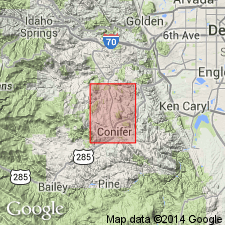
- Usage in publication:
-
- Pikes Peak Granite*
- Modifications:
-
- Mapped 1:24k (Conifer quad, Douglas and Jefferson Cos, CO)
- Dominant lithology:
-
- Granite
- AAPG geologic province:
-
- Southern Rocky Mountain region
Summary:
Is Precambrian Y [Middle Proterozoic] lithodeme mapped in west-central Jefferson Co, CO (Southern Rocky Mountain region). Is youngest Precambrian unit in quad. On Correlation of Map Units is shown to unconformably underlie Pleistocene older alluvium unit and to be younger than Silver Plume Quartz Monzonite (Precambrian Y). Unit is mapped in southwestern part of quad. Pikes Peak is described as coarse-grained white to moderate-orange-pink biotite and hornblende-biotite granite with a grain size of 0.5 to 2 cm. Forms large slabby outcrops and a thin very permeable sandy soil. Rb-Sr age is about 1,040 m.y. (Hedge, 1970, USGS P.P. 700-B, p.86-89).
Source: GNU records (USGS DDS-6; Denver GNULEX).
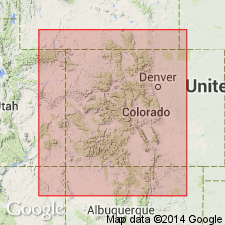
- Usage in publication:
-
- Pikes Peak Granite*
- Modifications:
-
- Overview
- AAPG geologic province:
-
- Southern Rocky Mountain region
Summary:
Is the chief rock of large composite Pikes Peak batholith. Name has been applied to many different compositional facies and intrusive bodies in batholith but properly should be restricted to coarse-grained granite or rank changed. Listed with granitic rocks of circa 1,000 m.y. (Precambrian Y) age group in Southern Rocky Mountain region.
Source: GNU records (USGS DDS-6; Denver GNULEX).
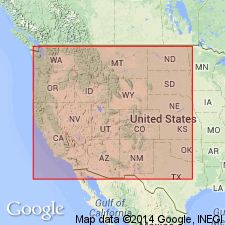
- Usage in publication:
-
- Pikes Peak Granite*
- Modifications:
-
- Geochronologic dating
- AAPG geologic province:
-
- Southern Rocky Mountain region
Summary:
Pg. 14, geologic time scale (inside front cover). Pikes Peak Granite. Sample from Lat. 38 deg. 52 min. N., Long. 105 deg. 07 min. W., Teller(?) County, Colorado, yielded a Pb-alpha age of 1,290 +/-145 Ma (zircon); age too old, may be result of xenocrystic contamination. Sample from Lat. 38 deg. 51 min. N., Long. 105 deg. 02 min. W., Pikes Peak quadrangle, El Paso or Teller County, Colorado, yielded Pb-alpha ages of 1,055 +/-115 Ma, 1,050 +/-115 Ma, and 995 +/-110 Ma (zircon). Ages published by Marvin, 1968 (USGS Misc. Geol. Inv. Map I-537); recalculated using decay constants of Steiger and Jager, 1977 (Earth Planet. Sci. Letters, v. 36, p. 359-362). Age of Pikes Peak approximately 1,000 Ma [Precambrian Y].
Source: Publication.
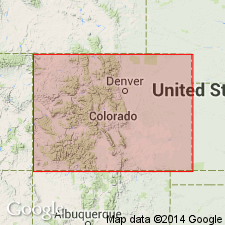
- Usage in publication:
-
- Pikes Peak Granite*
- Modifications:
-
- Overview
- AAPG geologic province:
-
- Southern Rocky Mountain region
Summary:
Is a pink to pale-orange, coarse-grained, massive, homogeneous granite that is part of Pikes Peak batholith, Southern Rocky Mountain region, CO. Disintegrates into a coarse, orange-red grus. Many rocks of the batholith (Mount Rosa, Windy Point, and Redskin Granites and related rocks) are excluded from the Pikes Peak Granite. The batholith occupies an area of about 3,100 km sq (1,200 mi sq) in the southern Front Range and is inferred to extend over a larger area in the subsurface. The Rb-Sr age of the batholith is about 1,020 m.y. Pikes Peak Granite is of Middle Proterozoic age.
Source: GNU records (USGS DDS-6; Denver GNULEX).
For more information, please contact Nancy Stamm, Geologic Names Committee Secretary.
Asterisk (*) indicates published by U.S. Geological Survey authors.
"No current usage" (†) implies that a name has been abandoned or has fallen into disuse. Former usage and, if known, replacement name given in parentheses ( ).
Slash (/) indicates name conflicts with nomenclatural guidelines (CSN, 1933; ACSN, 1961, 1970; NACSN, 1983, 2005, 2021). May be explained within brackets ([ ]).

